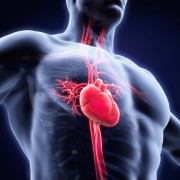Screening for coronary artery disease
Timely diagnosis and intervention key in reducing mortality from this common heart condition

It is hardly an overstatement that many consider coronary artery disease (CAD) one of the major threats to global health. The condition – a narrowing of the arteries due to fatty plaque that may cause a heart attack – was responsible for 7.4 million deaths in 2012 alone, according to the Worldwide Health Organization (WHO).
CAD is a chronic ailment that develops over several years or even decades, so early diagnosis is crucial to stop its progression and avoid heart failure.
Coronary angiography: diagnosis and therapy in one
“Coronary angiography is the gold standard for diagnosing coronary artery disease because it is a diagnostic tool with a therapeutic option,” says Dr Jeremy Chow, a consultant cardiologist at the Asian Heart & Vascular Centre in Singapore.
According to Dr Chow, most physicians now perform this procedure through the radial artery – a small artery in the wrist – where a small catheter, typically 2mm in diameter, is placed in the artery and fed along the artery path to the heart. “Once it is inside the heart, we are able to locate the two main arteries, the left and right coronary arteries and engage the artery using the catheter and inject dye specifically to look at the flow across the artery,” he says.
X-ray images are subsequently taken to monitor how the dye moves through the artery and locate any blockage in blood flow.
Dr Chow explains that when a blockage is found doctors can introduce other equipment into the artery, such as balloons, stents or wires in order to clear the obstruction and thereby prevent a future cardiac arrest.
Coronary computed tomography angiogram: a less invasive option
“The coronary computed tomography angiogram (CCTA) is a less invasive test to diagnose CAD because it only involves an intravenous injection of a contrast dye in the vein and usually can be done in around one hour,” explains Dr Chow.
During a CCTA, the contrast dye is followed through a CT scan to search for any blockage in the arteries without the need for a catheter.
Dr Chow adds that the accuracy rate of a CCTA is 99 percent, therefore when the machine does not detect any blockages there is no need to proceed with further evaluation.
However, a CCTA is less reliable when it comes to detecting serious obstruction, with its accuracy rate ranging from 70 to 80 percent, says Dr Chow. This means that someone who starts off with a CCTA may end up needing a coronary angiography as well to obtain a clearer picture of the blood vessels.
In addition, a CCTA needs a slow resting heart rate – normally between 60 and 75 beats per minute – in order to acquire clear images. “If the heart rate is very fast, you may end up having to do the CT scan a couple of times, which means your radiation dose may be a little bit higher,” says Dr Chow. “Whereas the coronary angiography doesn’t have that limitation, you can do it at any heart rate because we are seeing actual luminal flow directly during the imaging.”
Who needs to do a check-up?
Those individuals with a family history of heart disease or at least two risk factors for artery blockages, including smoking, high cholesterol levels, diabetes, or hypertension are encouraged for screening.
Patients in the at-risk group are required to undergo a stress test first, says Dr Chow, where an electrocardiography (ECG) machine monitors their heart function while they exercise on a treadmill.
If the stress test is abnormal, patients may then have to do a coronary angiography or CCTA, he adds.
 Dr Jeremy Chow is a cardiologist and electrophysiologist practising at Gleneagles Hospital in Singapore. His clinical interests are in arrhythmia management and stroke prevention in atrial fibrillation (AF). Dr Chow also educates athletes and high-risk group for sudden cardiac death screening by giving talks and recommending pre-participation screenings.
Dr Jeremy Chow is a cardiologist and electrophysiologist practising at Gleneagles Hospital in Singapore. His clinical interests are in arrhythmia management and stroke prevention in atrial fibrillation (AF). Dr Chow also educates athletes and high-risk group for sudden cardiac death screening by giving talks and recommending pre-participation screenings.
Gleneagles Hospital Singapore
6A Napier Road, Singapore 258500
Tel: +65 6735 5000
www.gleneagles.com.sg
Asian Heart & Vascular Centre
6 Napier Road #04-13
Gleneagles Medical Centre, Singapore 258499
Tel: +65 6473 9698
www.asianheart.com.sg
Related Articles
Why laughter may not be the best medicine
Dr Julian K.B. Tan, an interventional cardiologist at Mount Elizabeth Hospital, explains the how strong emotions may affect the heart
Read moreWhat is a heart attack?
Dr Paul Chiam discusses the importance of seeking treatment quickly in the case of a heart attack
Read moreLatest Articles
Medical Care
Clearing the Fog: Dispelling Common Diabetes Myths in Singapore
Uncover the truths and myths about diabetes with insights from Harmony Thyroid, Endocrinology and Diabetes Centre. Learn about prevention, diagnosis, and management strategies for diabetes in Singapore. Get expert guidance from Senior Consultant Endocrinologist Dr. Vikram Sonawane to navigate your diabetes journey effectively.
Read moreMedical Care
Achieving Swift Recovery: Enhanced Recovery (ERAS) Direct Anterior Approach Total Hip Replacement
Consider total hip replacement with Alps Orthopaedic Centre's ERAS Direct Anterior Approach for faster recovery and reduced hospital stays. Learn about Dr. Jerry Chen's expertise in Singapore.
Read moreMedical Care
Enhanced Recovery (ERAS) Total Knee Replacement
Discover how Alps Orthopaedic Centre's Enhanced Recovery After Surgery (ERAS) approach transforms total knee replacement into a day surgery, offering faster recovery, less pain, and reduced hospital bills. Learn about Dr. Jerry Chen's expertise and schedule your appointment in Singapore.
Read more